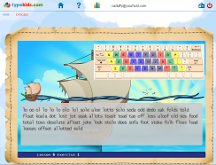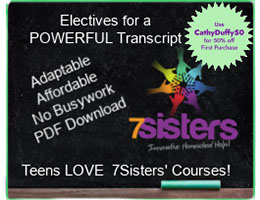Touch Typing for Kids is an online typing course for children. Children can learn to type in either English or Spanish while participating in a treasure hunt with the pirate Captain Forty. The story unfolds bit by bit as students progress through the lessons. You can skip the story segments if you want to, but the combination of storytelling with cartoon illustrations that they use is entertaining enough that most children will want to watch these segments.
Students complete exercises to unlock seven games in the Pirate Arcade. As they complete exercises correctly, they also accumulate coins that they need to “spend” to play the games. While the games are fun, they are really speed typing practice disguised as cute games with animations.
The program begins with instruction on hand placement on the home keys with animations and audio directions. The first lesson begins with only the left hand on the home keys, and then it shifts to the right hand on the home keys. (It seems to me that there is no instruction about the space bar in the first exercise, so you might have to explain it to your child before they begin since the program requires them to use it.) The second lesson combines both hands although students are still typing nonsense using only the home keys since they only are given practice with keys that have been taught. After only a few lessons, students move beyond nonsense so that they are frequently typing actual words. Later, they will be typing sentences and paragraphs as they add keys to their repertoire. The program continually reviews hand placement and also covers posture and ergonomics.
Exercises halt when an error is made until the student types the correct item. Exercises are not timed until lesson 17, so children do not feel pressured as they are just beginning to develop their skills. There are 30 lessons in the program, and each lesson should take about 25 minutes to complete.
One thing I find disconcerting in this program is their representation of the letter “l.” It has an extension to the left at the top, a form we don’t commonly encounter. Perhaps they do this to make the letter distinctly different from capital ‘I” or the number 1, but you might have to explain it to your child.
Simple animations make some of the lengthier exercises more interesting. For example, a ship moves progressively across the sea or young pirate Jack jumps from rock to rock to cross a river. Correct answers provide forward momentum, and there’s no backward movement.
The home page has images without visible text, and you have to scroll over the images to see the available options: exercises, review, stories, games, and messages. Sometimes it’s not clear what to do next, but it won’t hurt if students experiment with the options. Games will only be available if they have completed enough lessons, and the game option comes up automatically at certain points. Generally, students will be accessing the exercises from the home page. Clicking on the Review button brings up a screen with the keyboard showing areas of weakness on which the student should concentrate. Within the review screen, you can click on reviews of any of the previous lessons, but these are primarily instruction; students are only able to practice typing individual letters within the review section.
While I like TypeKids.com and think it will work well for children, there is one drawback that might matter in some situations. There is no way to jump around in the course—no way to jump ahead and no way to go back and practice a previous lesson. A child who already has beginning keyboard skills still has to work through all of the lessons.
The course concludes with an exam. If students pass the exam, they receive a TypeKids.com diploma.
While the program is suitable for children of all ages, even up into high school, younger children's hands need to be big enough to reach the keys properly.
A free trial is available.









